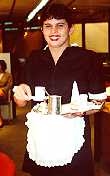One could sit here and write volumes about coffee in Brazil, but if you want to read a good book about it, go to your local library and look for a copy of Vassouras: A Brazilian Coffee County, 1850-1890. The Roles of Planter and Slave in a Changing Society. Stanley J. Stein. New York: Atheneum, 1976. Instead, we'll tell you a little about cafezinho, a word that more than being a diminutive for cafΘ is almost a synonym for welcome in Brazil. And we'll give you a traditional recipe passed on from generation to generation in the interior of Bahia, as it was given to us.

Serving cafezinho with a smile...
I'll start with a confession: I can't drink real coffee anymore, not all the time anyway, so as a result, instead of having decaf, I pass. The exception is when I go to Brazil. How can I say no to an institution and be labeled a "wimpy American?" Wherever you go, the minute you walk in the door, someone will pop the question "vocΩ toma um cafezinho?" (do you want a cafezinho?) and they won't take no for an answer. Or maybe they won't even ask and the cafezinho will soon materialize on a dainty tray brought in by a maid. In offices, someone will come by and serve cafezinhos to you at your desk, so don't be surprised if, smack in the middle of a business discussion, your Brazilian counterpart offers you a cafezinho too. And, at that point, the conversation may well switch to a non-business topic while you sip away at your coffee.

My favorite coffee.
Recipe for traditional cafezinho:
For each cup of water, use a heaping Tbsp of GOOD coffee ground for espresso. Add sugar to taste. This is how it's done. You'll need a saucepan that you'll promise to use ONLY for making coffee (cross your heart and hope to die). Add water to the pan, add the sugar and dissolve well. Bring to boil over medium heat. When the water and sugar mixture boils, add the coffee powder, stir well and remove from heat immediately.

This antique coffee maker comes from Minas Gerais.
The coffee pot goes in the bottom and the strainer fits into the hole.
The next thing you'll need is a traditional cloth coffee strainer. These can be found in any market in Brazil or in Latino markets in the US. If you don't have the real thing use a paper filter or a Gold filter. Pour into a tiny cup. A demitasse will do in the US, but if you go to Brazil, buy the real thing there; they're usually really small. Ah, if you can find the microspoons decorated with Brazilian stones - Brazilians usually find them the epitome of kitsch - you'll wow your guests every time!

Jenny likes her cafezinho in a glass.
More on Brazilian Food & Eating Habits.